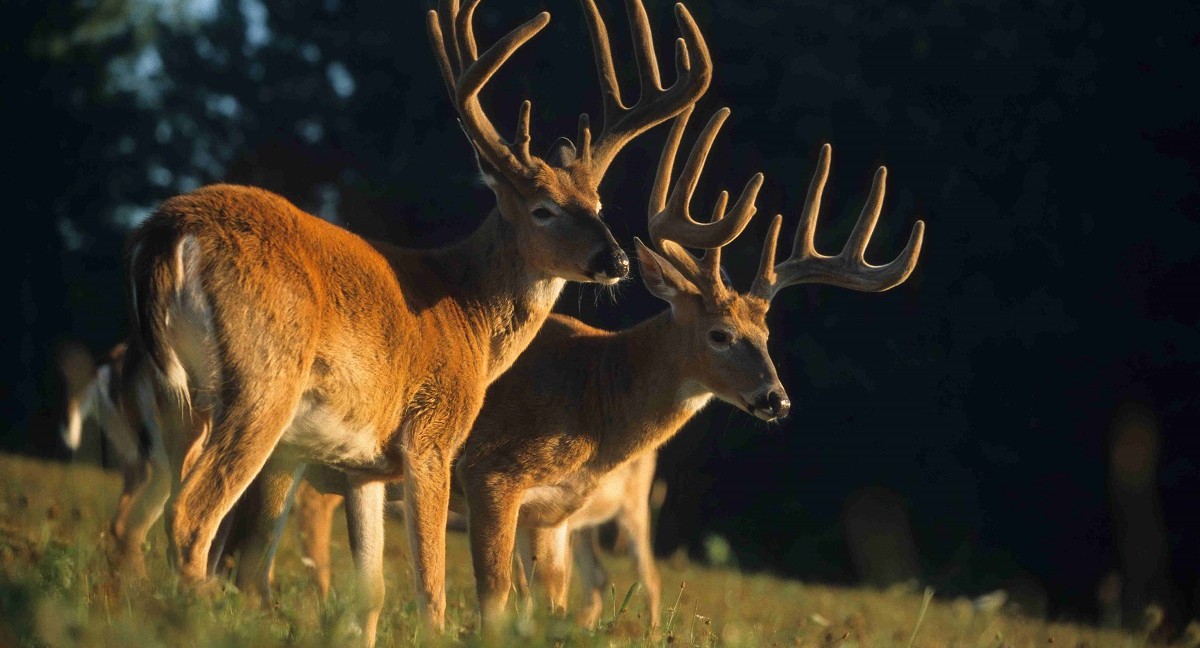Within the deer population males and females occupy different areas of their range. Except for interaction around common food sources bucks and does seldom interact with each other during the non-rutting months. In the bucks’ case, how they socialize with other bucks is predicated on their personality, age, and social position within the herd. A fascinating aspect of bachelor group behavior is the way members transition from being “groupies” from winter through summer, to breaking up and going their separate ways come fall.
Composition of the Group
Bachelor groups are made up of at least two bucks and it is not uncommon to see six or more mature bucks co-existing in a group. In most cases age will determine the make-up of the group, with one truly dominant buck and other subordinate bucks making up each group. Though mature bucks (2+ years of age) will sometimes allow yearling bucks to be a part of their bachelor group this is usually not the case, at least in a herd with a good sampling of mature bucks. When it comes to whitetail bucks there is definitely a class system—so, it takes time for yearling bucks to be accepted into a mature buck’s world.
 A bachelor group of mature bucks feeding during a summer evening.
A bachelor group of mature bucks feeding during a summer evening.
Yearling Bachelor Groups
By the time a yearling reaches 1 ½ years of age it has dispersed from its mother and her home range. In the process it may travel 25 or more miles before it finds a home range to its liking, though most dispersal finds them venturing little more than 5 to10 miles from where they were born. During its dispersal a yearling encounters all age classes of bucks. Because very few mature bucks will accept yearling bucks they quickly learn to steer clear of mature, more dominant bucks. This rejection by mature bucks causes them to form groups with other like-age bucks to spend their second summer.
Mature Bachelor Groups
When a buck reaches two years of age he begins to be accepted by older bucks. Mature bachelor groups are generally more reclusive, especially during the summer months in farm country where they seldom cover more than 600-acres.
It’s within the mature bachelor groups that rutting hierarchy is often sifted out well in advance of the rut. They do this by casually testing each other and in some cases aggressive bullying occurs. This can manifest itself when one buck exhibits what I call threat walking (ears pulled back, eyes rolled, bristled up hair, and stiff legged walking) toward another buck within the group. Another way bucks test each other within the group is by standing on their hind legs and actually boxing with each other. These behaviors can occur at any time, but especially in August when velvet clad antlers reach their maximum size and begin to harden.
 Two mature bucks bonding in their bachelor group.
Two mature bucks bonding in their bachelor group.
Interaction
The behaviors exhibited within a bachelor group are many. During the months that mature bucks range together they often pair up with another buck of like personality within the group. These bucks are usually very tolerant of one another and exhibit this by the way they will gently groom each other. In addition, younger mature bucks within a bachelor group often try to gain favor with an older buck by grooming him. The older buck will not always tolerate this approach, but if he does it is a way for the younger buck to gain acceptance.

Two similar sized mature bucks grooming each other in August.
Bucks making up a bachelor group, be it yearling or mature, will often bed reasonably close to each other, in some cases within yards. Seldom will they bed where they have direct eye contact and usually bed facing different directions so they can cover each other’s back as a way to alert each other of predators.
Copy-cat behavior is also quite common within mature bachelor groups. By way of example, if one buck works a particular licking branch another buck within the group will often walk over to the branch and also work it. During summer months bucks are constantly laying down scent and the majority of this scent marking is done through licking branch behavior.

Two mature bucks in a summer bachelor group leaving their scent on a licking branch.
Another behavior that occurs often within bachelor groups during summer months takes place in areas frequented by does (like a big food plot). It is what I refer to as domino lip curling. When does move into the field to feed they will usually urinate one or more times while there. If a buck is feeding nearby and notices it, he will walk over to the location, smell the urine, and lip curl. Other bucks that see what is going on will often follow suit.
Party is Over!
Around September 1st in the North a buck’s testosterone level begins to rise and velvet is peeled. From this point on group hierarchy is tested on a daily basis. Once velvet is peeled sparring rules the day. Though most are nothing more than shoving matches some can and do turn ugly. Now every mature buck lives to be king of the woods. Unfortunately only one can rule the group’s summer home range, so sparring, threat walking and other aggressive behaviors sort things out rather quickly. Between September 1st and October 1st hormone levels double causing the less dominant bucks to begin covering more and more range looking for an area where they can be the dominant buck.
 By the end of September heavy dominance traits begin manifesting themselves – in this case threat walking.
By the end of September heavy dominance traits begin manifesting themselves – in this case threat walking.
By October 1st in the North, bachelor groups that coexisted throughout the summer have dispersed. Only when the rut is over will surviving bucks be drawn to form or reform a bachelor group that will stay together until the following September.
 A buck on the move. By early October bachelor group behavior has pretty much ended as bucks begin to cover greater amounts of ground.
A buck on the move. By early October bachelor group behavior has pretty much ended as bucks begin to cover greater amounts of ground.







